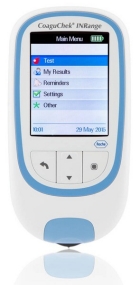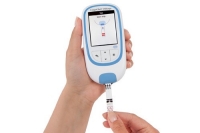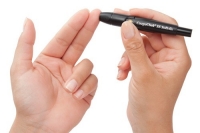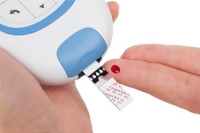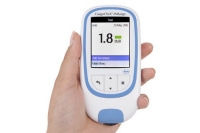CoaguChek® INRange 시스템
CoaguChek INRange는 항응고제 치료가 잘 관리될 수
있도록 언제 어디서나 PT/INR을 검사할 수 있는 자가
검사 측정기입니다.
내장된 무선 Bluetooth® 기술로 의료진이 환자와 연결할 수 있으며,
환자는 이제 자신의 측정기에서 PT/INR 결과를 의료진에게 전송할 수
있습니다.
이를 통해 언제 어디서나 환자를 지속적으로 추적 관리할 수 있습니다.
CoaguChek 기술과 품질을 통해 안전하고 정확하며 믿을 수 있는 자가
검사를 손쉽게 수행할 수 있습니다.1
치료 효과 개선
치료 범위 내 시간 비율이 높은 환자 (> 70%)는 임상 결과가 더 좋습니다.2,3
More engaged patients
Patients who self-test are more engaged in their own care, test more often and spend more time in range.4,5
환자 자가 검사의 의미
환자 자가 검사는 병원에서만 검사를 수행할 때 보다 치료 범위 내 시간을 늘리고,6-8 INR 값의 큰 변동을 줄이고6-8 INR 값의 큰 변동을 줄이고,8 혈전색전증을 낮추고,9-10 환자의 삶의 질과,11,12 치료 만족도를 높이는 것으로11,13 확인되었습니다.

환자 측정기와 연결을 통해
효과적으로 환자 관리
CoaguChek INRange 시스템을 통한 주기적인 검사로 치료
효과를 개선할 수 있습니다.
CoaguChek INRange는 환자와 의료진을 더 잘 연결하기 위해 결과 이상의 정보를 제공합니다. 추이 보고서, 추가설명 및 컬러
그래프로 환자의 PT/INR 추세를 바로 확인할 수 있습니다.
결과 추이 보고
CoaguChek INRange 측정기는 가장 최근 결과가 마지막
결과보다 높거나 낮은지를 표시하여 환자가 자신의 상태나
추이를 쉽게 파악할 수 있도록 합니다.
Bluetooth 또는 USB 연결
Bluetooth 또는 USB로 측정기를 연결하여 쉽고 빠르게 의료진에게 결과를 전송할 수 있습니다. CoaguChek INRange 측정기에서 데이터 전송에 호환되는 소프트웨어에 대한
자세한 내용은 가까운 Roche Diagnostics 고객 지원 센터에 문의하십시오.
설명
환자가 결과에 영향을 준 과거 행위를 기억하는 데 도움이
되도록 각 결과에 최대 6개의 설명을 입력할 수 있습니다.
CoaguChek INRange 키트는 다음 구성품으로 이루어집니다.
- CoaguChek INRange 측정기
-
CoaguChek XS Softclix 채혈기
- 공유 사용 금지
- CoaguChek Softclix 채혈침(10개)
- 휴대용 케이스
- 사용자 설명서
- 간략한 설명서
- USB 케이블
- AAA 건전지 4개
추가 필수 구성품:
- CoaguChek XS PT 검사, PST 검사지
(시약 통)
CoaguChek INRange 시스템 사용법 영상
- 측정 및 검체 채취
-
검출 시스템
인간 재조합 트롬보플라스틴으로 응고 활성화 후 PT 시간의 검출(전기 화학) 전류 측정사용자 인터페이스
컬러 디스플레이, 켜기/끄기, 입력, 뒤 및 위/아래 버튼이 있는 직관적인 사용자 인터페이스검체 적용
검사지의 위쪽이나 측면 (왼쪽 또는 오른쪽)으로 혈액을 투입 - 작동 조건
-
온도
+ 15°C ~ + 32°C습도
10 ~ 85%최대 고도
4300 m (14,000 ft)설치
- 첫 번째: 진동이 없는 평평한 표면에 모니터를 놓고 작동
- 두 번째: 수평이 되도록 모니터를 손으로 잡음INR 측정 범위
0.8 - 8.0인터페이스
USB(타입 B) 및 Bluetooth전원
건전지 - 1.5v AAA 알칼리 망간 건전지 4개배터리 세트당 검사 수
최대 60회 또는 1년크기
145 x 75 x 30 mm중량
135 g (건전지 제외)메모리
검사 결과 400개 저장자동 전원 끄기
2분 이상 사용하지 않을 경우 자동으로 꺼짐
- 검체
-
검체 유형
신선한 모세혈검체량
8 µl간섭
검사지 사용 설명서를 참조하십시오. - 검사지
-
ISI
약 1.0헤파린에 대한 민감도
Not at therapeutic levels, up to 0.8 I.U/ml for UFH and to 2 anti-Xa U/ml for LMWH정도 관리
검사지에 일반 검사와 동일한 방법으로 검사안정성
생산일을 기준으로 21개월(+ 2°C ~ + 30°C) - 디스플레이
-
컬러
목표 범위 표시
- 참고문헌
-
1. Sharma, P., Scotland, G., Cruickshank, M., Tassie, E., Fraser, C., et al. (2015). Is self-monitoring an effective option for people receiving long-term vitamin K antagonist therapy? A systematic review and economic evaluation. BMJ Open 5:e007758
2. Gallagher, A.M., Setakis, E., Plumb, J.M., Clemens, A., van Staa, T.P. (2011). Risks of stroke and mortality associated with suboptimal anticoagulation in atrial fibrillation patients. Thromb Haemost 106, 968–977
3. Wan, Y., Heneghan, C., Perera, R., Roberts, N., Hollowell, J., et al. (2008). Anticoagulation control and prediction of adverse events in patients with atrial fibrillation: a systematic review. Circ Cardiovasc Qual Outcomes 1, 84–91
4. Ward A, Tompson A, Fitzmaurice D, Sutton S, Perera R., et al. (2015). Cohort study of Anticoagulation Self-Monitoring (CASM): a prospective study of its effectiveness in the community. Br J Gen Pract. 65(636):e428-437
5. Heneghan C., Ward A., Perera R., et al. (2012). Self-monitoring of oral anticoagulation: systematic review and meta-analysis of individual patient data. Lancet 379:322-334
6. Bereznicki, L.R.E., Jackson, S.L., Peterson, G.M. (2013). Supervised patient self-testing of warfarin therapy using an online system. J Med Internet Res 15, e138
7. Christensen, H., Lauterlein, J.-J., Sørensen, P.D., Petersen, E.R.B., Madsen, et al. (2011). Home management of oral anticoagulation via telemedicine versus conventional hospital-based treatment. Telemed J E-Health Off J Am Telemed Assoc 17, 169–176
8. Bussey, H.I., Bussey M., Bussey-Smith K.L., Frei, C.R. (2013). Evaluation of warfarin management with international normalized ratio self-testing and online remote monitoring and management plus low-dose vitamin k with genomic considerations: a pilot study. Pharmacotherapy 33, 1136–1146
9. Heneghan, C., Ward, A., Perera, R., Bankhead, C., Fuller, A., et al. (2012). Self-monitoring of oral anticoagulation: systematic review and meta-analysis of individual patient data. Lancet 379, 322–334
10. Heneghan, C., Alonso-Coello, P., Garcia-Alamino, J.M., Perera, R., Meats, E., Glasziou, P. (2006). Self-monitoring of oral anticoagulation: a systematic review and meta-analysis. Lancet 367, 404–411
11. Matchar, D.B., Jacobson, A., Dolor, R., Edson, R., Uyeda, L., et al. (2010). Effect of home testing of international normalized ratio on clinical events. N Engl J Med 363, 1608–1620
12. Salvador, C.H., Ruiz-Sanchez, A., González de Mingo, M.A., Carmona Rodríguez, M., Carrasco, et al. (2008). Evaluation of a telemedicine based service for the follow-up and monitoring of patients treated with oral anticoagulant therapy. EEE Trans Inf Technol Biomed 12, 696–706
13. Gardiner, C., Williams, K., Mackie, I.J., Machin, S.J., Cohen, H. (2005). Patient self-testing is a reliable and acceptable alternative to laboratory INR monitoring. Br J Haematol 128, 242–247




